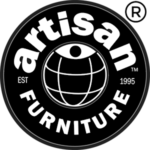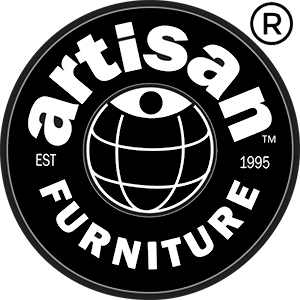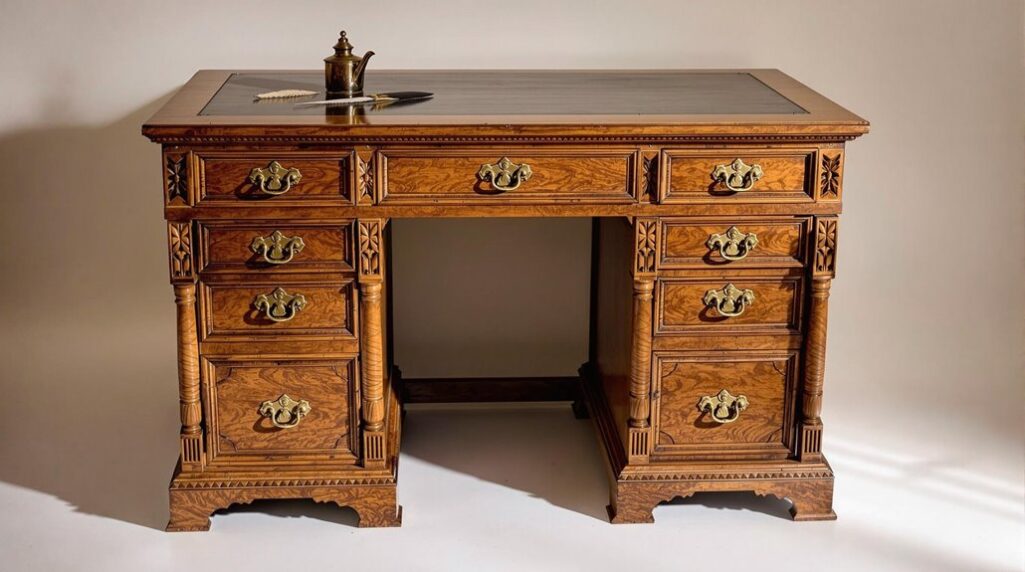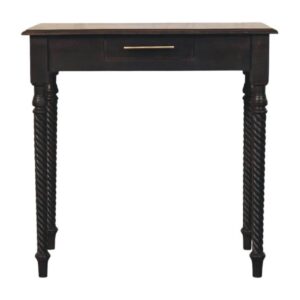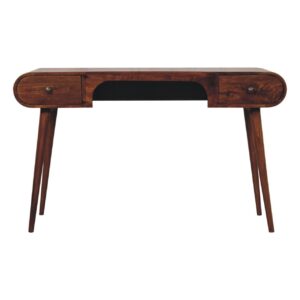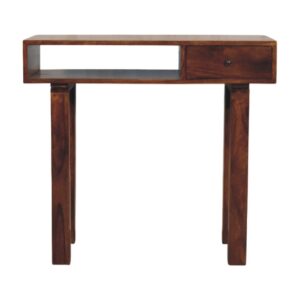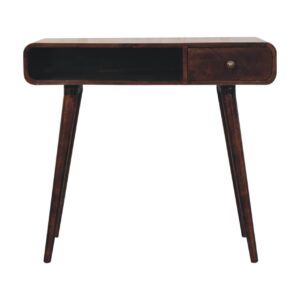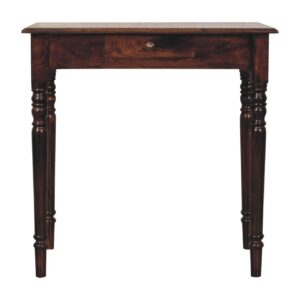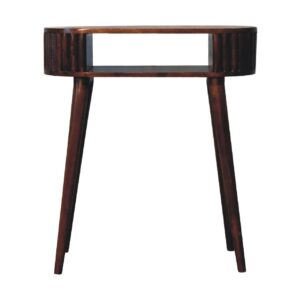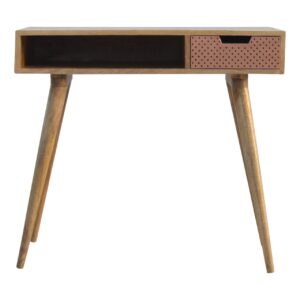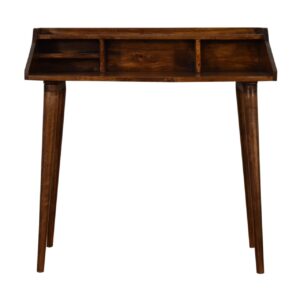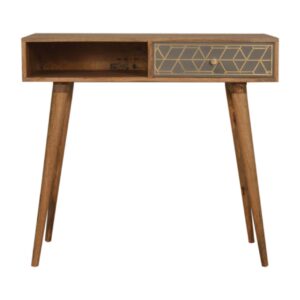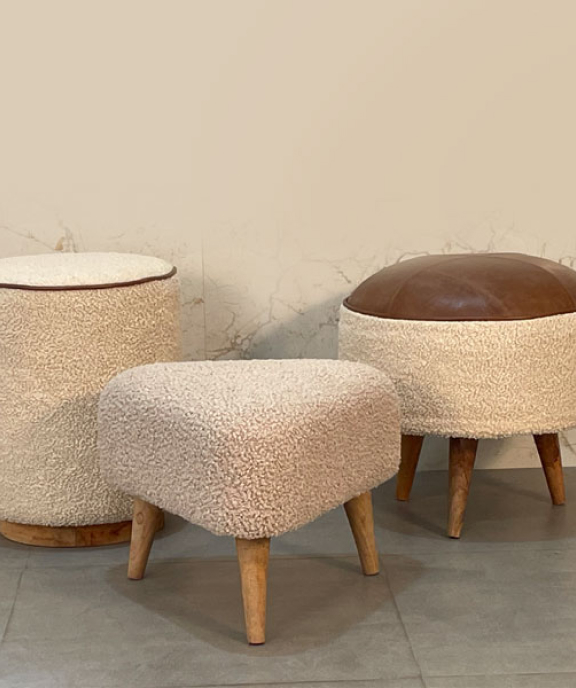The term "old-fashioned desk" refers to several classic designs that have historical significance. These include writing desks, ideal for minimalism; secretary desks, which feature foldable surfaces for organization; roll-top desks, known for their unique retractable covers and ample storage; and drop-leaf desks, designed for space-saving versatility. Each type highlights distinct aesthetics and functionality, reflecting the craftsmanship of different eras. Understanding these styles can enhance your appreciation for antique furniture, offering both practical use and decorative charm. Learning about their features and contexts can provide deeper insights into their enduring appeal and relevance in modern interiors.
Historical Context of Desks
As you explore the historical context of desks, you'll find that they've evolved considerably over the centuries. Initially, desks served as simple surfaces for writing, often made from local materials. In the Middle Ages, they transformed into more structured designs, reflecting the needs of scholars and clerics. As education expanded during the Renaissance, desks became essential in schools and homes, incorporating features like drawers and compartments for organization. By the 18th and 19th centuries, craftsmanship flourished, leading to ornate styles that showcased the woodworker's skill. With the Industrial Revolution, mass production changed desk construction, making them accessible to a broader audience. Today, while technology influences desk design, the essence of functionality and workspace remains rooted in this rich history.
Types of Old-Fashioned Desks
When exploring types of old-fashioned desks, you'll find that writing desks and secretary desks stand out for their unique features and functionality. Writing desks typically emphasize a flat surface for writing and minimal storage, while secretary desks often include compartments and foldable surfaces for added organization and privacy. Understanding these distinctions can help you appreciate how each design caters to different needs and preferences.
Writing Desks Overview
Old-fashioned writing desks come in a variety of styles, each with its unique charm and functionality. You'll find options such as the traditional roll-top desk, which features a retractable cover for privacy and organization, and the elegant writing table, known for its minimalist design and spacious surface. The kidney-shaped desk offers a blend of aesthetic appeal and practicality, allowing you to work comfortably. Additionally, the drop-leaf desk is designed for versatility, enabling you to extend or reduce its size based on your needs. Each type serves distinct purposes, whether for writing, reading, or managing documents, while also enhancing your workspace's overall character. Choosing the right style can greatly impact both your productivity and the ambiance of your office.
Secretary Desks Features
Secretary desks, often celebrated for their blend of form and function, offer a unique workspace solution that caters to both aesthetics and practicality. These desks typically feature a drop-down front that transforms into a writing surface, allowing you to conceal or display your work as needed. They often include multiple drawers and compartments, providing ample storage for office supplies, documents, and personal items. Many designs incorporate intricate woodwork or decorative elements, enhancing their visual appeal. You'll find options in various styles, from traditional to modern, accommodating different tastes. Additionally, their compact size makes them suitable for smaller spaces, demonstrating versatility while maintaining an elegant presence in your home or office environment.
The Writing Desk
The writing desk stands as a timeless symbol of creativity and productivity. It's designed for focus, offering a dedicated space for your thoughts to flow onto paper. Typically, these desks feature a flat surface with ample space for writing instruments, notebooks, or laptops. You'll find various styles ranging from minimalist to ornate, allowing you to choose one that suits your aesthetic. Many writing desks come with drawers or compartments, providing convenient storage for essential tools, helping to keep your workspace organized. The height and design promote ergonomic comfort, encouraging longer periods of writing without strain. Essentially, a writing desk not only enhances your productivity but also reflects your personal style and commitment to the craft of writing.
Roll-Top Desk Features
When you consider a roll-top desk, you'll notice its unique design and aesthetics, which blend functionality with an elegant appearance. These desks not only provide ample storage space but also reflect a historical significance that dates back to the 19th century, making them a staple in many traditional workspaces. Understanding these features can help you appreciate how a roll-top desk serves both practical needs and as a conversation piece in your home or office.
Design and Aesthetics
Roll-top desks embody a blend of functionality and elegance that appeals to many. Their distinctive curved top, which slides open and closed, not only serves as a unique design feature but also enhances the desk's overall aesthetic. Crafted from rich woods like mahogany or oak, these desks often showcase intricate carvings and polished finishes, contributing to their timeless appeal. The design typically includes multiple compartments and shelves, allowing for efficient organization while maintaining a classic look. The combination of practical elements and refined craftsmanship makes them suitable for various decor styles, from traditional to eclectic. Ultimately, the roll-top desk stands out as a statement piece, marrying beauty with an iconic silhouette that resonates in both historical and modern settings.
Functionality and Storage
While you might appreciate the elegance of a roll-top desk, its functionality and storage capabilities are equally impressive. The design features a flexible tambour, allowing you to easily conceal your workspace when it's not in use. This not only keeps the area tidy but also adds a layer of privacy. Inside, you'll find multiple compartments and drawers, ideal for organizing papers, stationery, and personal items. The variety of storage options means you can customize your setup to fit your needs, whether you're working on projects or handling everyday tasks. Additionally, the solid construction of a roll-top desk guarantees durability, making it a practical investment for both functionality and longevity in your home or office environment.
Historical Significance and Use
The roll-top desk isn't just a functional piece of furniture; it carries a rich historical significance that reflects the evolution of workspace design. Originating in the late 19th century, these desks were popular among professionals, providing both organization and privacy in bustling offices. Their unique design, featuring a curved, retractable top, allowed users to conceal their work when not in use, promoting a sense of order and control. As you examine the craftsmanship, consider how the intricate woodwork and hardware illustrate the era's dedication to quality and style. In addition, the roll-top desk symbolizes the shift from traditional, open workspaces to more personalized environments, showcasing changing attitudes toward productivity and individualism in the workplace throughout history.
The Secretary Desk
A charming blend of functionality and elegance, the secretary desk has long been a staple in home offices and studies. This versatile piece of furniture typically features a hinged writing surface that can be folded away, allowing for a clean appearance when not in use. You'll often find compartments and drawers designed to store stationery, documents, and other essentials, promoting organization. The design may vary, showcasing intricate carvings or a sleek, modern aesthetic, but its purpose remains consistent: to provide a dedicated workspace while enhancing the room's decor. When you're looking for a blend of style and utility, a secretary desk could be the perfect addition, merging practicality with timeless design for both work and leisure.
Drop-Leaf Desk Design
When you need a workspace that adapts to your changing needs, the drop-leaf desk design offers an ideal solution. This versatile furniture piece features hinged leaves that can be raised or lowered, allowing you to adjust the desk's size according to your requirements. When folded down, it occupies minimal space, making it perfect for small rooms or multifunctional areas. When you need more surface area for tasks like writing or crafting, simply extend the leaves. The design dates back to the 17th century, showcasing both functionality and elegance. Crafted from various materials, including wood and metal, these desks can complement diverse interior styles while providing practical usability for modern living.
Antique Desks in Modern Homes
Incorporating antique desks into modern homes not only adds character but also bridges the gap between past and present design aesthetics. These desks often feature intricate craftsmanship, unique materials, and historical significance, enhancing the overall decor. You can use an antique desk as a focal point in a home office or study, providing a striking contrast to contemporary furnishings. They also serve practical purposes; their spacious surfaces and built-in storage options offer functionality without sacrificing style. Additionally, mixing antique desks with modern elements can create an eclectic vibe that showcases your personal taste. By thoughtfully selecting an antique desk, you can create a harmonious balance, merging timeless elegance with contemporary living. Such choices reflect a deeper appreciation for history and craftsmanship.
Caring for Vintage Desks
Caring for vintage desks is essential to preserve their beauty and functionality, especially since these pieces often carry considerable historical value. Start by regularly dusting the surface with a soft cloth to prevent dirt buildup. Avoid using harsh chemicals; instead, opt for a gentle wood cleaner specifically designed for antique finishes. When dealing with scratches, consider applying a wax or polish that matches the wood type to restore its luster. To protect the desk from moisture, use coasters and avoid placing hot items directly on the surface. If the desk has drawers, check for proper alignment and lubrication to guarantee smooth operation. Regular inspections and minor repairs can greatly extend the life of your vintage desk, maintaining its integrity for years.
